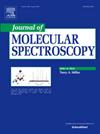Three-states model for calculating the X-X rovibrational transition intensities in hydroxyl radical
IF 1.3
4区 物理与天体物理
Q4 PHYSICS, ATOMIC, MOLECULAR & CHEMICAL
引用次数: 0
Abstract
The best available line list of OH [Brooke et al. JQSRT, 168 (2016) 142] contains the high-quality line frequencies, yet the line intensities need refinement because the model function used to interpolate the RKR potential and to extrapolate it into the repulsion region was not analytic [Medvedev et al. Mol. Phys. doi: 10.1080/00268976.2024.2395439], and also because the coupling between the ground and first excited electronic states was treated by the perturbation theory. In this paper, we performed ab initio calculations of all necessary molecular functions at -8.0 bohr, and then we construct fully analytic model functions entering the Hamiltonian. The model functions were fitted to both the ab initio data and the available experimental data on the line positions and energy levels, the relative line intensities, and the transition dipole moments derived from the measured permanent dipoles. The system of three coupled Schrödinger equations for two multiplet components of the state plus the state was solved to calculate the energy levels and the line intensities. The new set of the Einstein A coefficients permits to decrease the scatter of the logarithmic populations of the ro-vibrational levels derived from the observed radiation fluxes [Noll et al. Atmos. Chem. Phys. 20 (2020) 5269], to achieve better agreement with the measured relative intensities, and to obtain significant differences in the intensities of the doublets for large and as observed by Noll et al. The - coupling fully modifies the Q-line intensities at high by removing the well-known dependence. A new line list is constructed where the transition frequencies are from Brooke et al. and the Einstein coefficients are from the present study. However, not all the problems with the intensities were resolved, presumably due to the neglect of the interaction with the and repulsive electronic terms.

计算羟基自由基中X-X旋转振动跃迁强度的三态模型
OH的最佳可用线列表[Brooke等]。JQSRT, 168(2016) 142]包含高质量的线频率,但线强度需要改进,因为用于插值RKR势并将其外推到排斥区域的模型函数不是解析的[Medvedev等]。摩尔。物理。[doi: 10.1080/00268976.2024.2395439],也因为地面X2Π和第一激发态A2Σ+电子态之间的耦合是用摄动理论处理的。本文在r=0.4-8.0玻尔条件下,从头计算了所有必需的分子函数,并构造了进入哈密顿量的全解析模型函数。将模型函数拟合到从头算数据和现有的实验数据上,拟合了线的位置和能级、相对线强度以及由测量的永久偶极子得到的跃迁偶极子矩。求解了X态和A态两个多重分量的三个耦合系统Schrödinger方程,计算了能级和线强度。新的爱因斯坦A系数集允许减少由观测到的辐射通量导出的反振动能级的对数总体的散射[Noll等人]。大气压。化学。Phys. 20(2020) 5269],以获得与测量的相对强度更好的一致性,并获得Noll等人观察到的大v和J的Λ双重态强度的显着差异。通过消除众所周知的J−2依赖性,X-A耦合完全改变了高J处的q线强度。我们构建了一个新的谱线列表,其中的跃迁频率来自Brooke等人,爱因斯坦A系数来自本研究。然而,并不是所有的强度问题都得到了解决,可能是由于忽略了与4Σ−,2Σ−和4Π的排斥电子项的相互作用。
本文章由计算机程序翻译,如有差异,请以英文原文为准。
求助全文
约1分钟内获得全文
求助全文
来源期刊
CiteScore
2.70
自引率
21.40%
发文量
94
审稿时长
29 days
期刊介绍:
The Journal of Molecular Spectroscopy presents experimental and theoretical articles on all subjects relevant to molecular spectroscopy and its modern applications. An international medium for the publication of some of the most significant research in the field, the Journal of Molecular Spectroscopy is an invaluable resource for astrophysicists, chemists, physicists, engineers, and others involved in molecular spectroscopy research and practice.

 求助内容:
求助内容: 应助结果提醒方式:
应助结果提醒方式:


